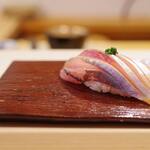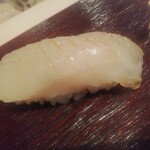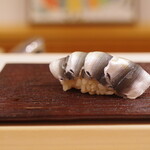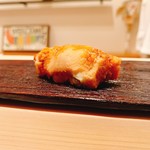
鮨いち伍
Sushiichigo
3.32
Shimotakaido–Chitosekarasuyama
「Sushi」
15,000-19,999円
--
Opening hours: 17:00-22:00 Open Sundays
Rest time: Monday
東京都世田谷区粕谷4-18-7
Photos
(20)




















Details
Reservation Info
can be reserved
Children
Children are allowed.
Counter seating only, so please make reservations in advance and consult with us.
Payment Method
Cards accepted
(JCB, AMEX, Diners)
Number of Seats
8 seats
(There are four tables in the back, but they are not usually used.)
Private Dining Rooms
None
Smoking and Non-Smoking
No smoking at the table
Parking
None
Facilities
Calm space, counter seating available
Drink
Wine available, stick to sake, stick to shochu
Dishes
Focus on fish dishes
Comments
(21)
とあるお鮨の禁書目録-食べログ-
4.50
When you pass through the residential area of Sengoku, you can see "Sushi Ichigo" restaurant. The interior of the restaurant is smartly arranged, creating a clean and elegant space. The warm and friendly service of Master Tatsuya Higuchi is wonderful. The course quietly begins. I enjoy a glass of beer and early summer water eggplant. A platter is brought to the table, featuring yuba and fiddlehead fern, flounder, mantis shrimp, and tender octopus simmered in a soft manner. There is also a combination of Hakodate's fresh Atka mackerel and pickled zha cai. Then comes a dish of daifuku steamed rice with warm sea urchin sauce. The rock oyster is served, followed by tender and sweet swordtip squid. The flavor of the shari rice follows immediately. The rice is cooked plump and strong, and it melts in your mouth. Despite its gentle impression, the shari rice is well-defined and elegant. The spring child has a gentle texture, with condensed umami and a fragrant aroma. The bonito has a pleasant acidity, and the chewed green onion adds freshness. The medium fatty tuna melts smoothly with a sweet flavor. The turban shell has a glossy aroma that intertwines with the shari rice. The shallow clam is served without seaweed to avoid interference, bursting with delicate umami and intense aroma. The horse mackerel has a high aroma and a sharpness in its fat. The small fin has a gentle acidity that enhances the umami. The small fin leaves a refreshing impression. Sea urchin. Miso soup. The conger eel is plump and fragrant. Tamago. I order an additional serving. The flounder has a refined aroma. The ark shell is peeled after the order is placed. It is incredibly fragrant with a fruity sweetness that overflows. Being able to eat it all the way to the string is a blessing. The simmered oyster is rich, fine-grained, and melts away. It is creamy and perfectly cooked. Dried gourd. Green plum wine stew, intoxicating taste. Thank you for the feast.




むむむ616
5.00
Highlight of June, beloved sushi restaurant "Ichigo". To celebrate my birthday and Father's Day, I took my parents there for a special meal with great sake. The elegant interior, beautiful wooden carvings on the walls, and lovely tableware impressed my mother, who hadn't been there in years. We enjoyed dishes like black dragon daiginjo sake, madai, jun-sai, hokki clam, iwagaki oyster, uni, and shrimp. The grilled tachiuo and steamed dish with mozuku sauce were delicious. The sushi, with less vinegar in the rice for the seniors, included squid, torigai, aji, anago, and uni. My father, who loves squid and torigai, was happy with the easy-to-eat and flavorful sushi. The fatty tuna, kohada, horse mackerel, conger eel, and uni were all fantastic. The dessert of plum and jade was a burst of seasonal flavors. The restaurant has been highly praised and recommended in various guides and TV shows. My husband even said it's better than Kyubei and knowing Ichigo is key to knowing Kuroyama. It was convenient to use Setagaya Pay.




susa28
4.00
The atmosphere of the restaurant was lovely, the appetizers were delicious, and the sushi rice and toppings were perfectly matched, creating a wonderful harmony. Each bite was a delight, and I had a truly happy time. Everything was delicious, but the sea bream and clams left a lasting impression. The conversations with the chef and his wife were enjoyable, and the other customers were also lovely. I would love to visit again soon. Thank you very much.




pirorinpa
4.00
It's probably been about 4 years since I last visited. I went for the first time in 2018, and returned in 2019 with a companion, but those records are gone and only memories remain. Finally, after 4 years, I visited again. Oh, but it was really delicious. Recently, a new sushi restaurant opened in my favorite town, but authentic Edo-style sushi is truly incomparable. The attention to detail in the preparation, from the ingredients to the final sushi, is top-notch. Ichigo-san serves delicious appetizers and the sushi is small but so good that you can't stop eating. While at the new sushi place, I use chopsticks, but here at the Edo-style restaurant, I eat with my hands. It feels like I'm reaching out to the sushi with my hands. That quality suits it perfectly. The white roe of the sea bream was a first for me, and it was delicious. The sea urchin was incredibly sweet and rich, making it even more delicious. The vinegared rice was excellent. I had Japanese sake from Hidashim, Kokuryu, and one more that I forgot, and they all went down smoothly, so be careful not to drink too much. Next time, I want to try eating at Arai-san, which is on the same street, and revisit Ichigo-san. It's not about comparing, but having an outstanding option nearby. It was really delicious. Thank you for the meal.




名総
4.20
I have been visiting this shop since it opened. They constantly experiment with different flavors, even with the same ingredients, depending on the season and year. They offer a variety of dishes such as straw-grilled, pickled, finishing dishes, and stick sushi. They carefully select tuna from different fishing ports depending on the season. The sushi is served in limited quantities and the composition is never repeated. The balance of the Edo-style sushi with an added touch and slightly spicy vinegar rice is the result of their trial and error. The extra effort they put in can be clearly seen, and becoming a good customer requires continuous improvement.




うにくまる
4.00
Sushi Ichi Go @ Senzoku Karasuyama It's been a while since I last visited! The atmosphere inside the restaurant is quiet with a slight sense of tension, but chatting with the head chef helps to ease the tension. This place only offers an omakase course. Today's course included: - Edamame - Karasumi (bottarga) with Sayuri, iwashi (sardine) sushi, hotaruika (firefly squid), yariika (spear squid), assorted sashimi - Grilled nodoguro (blackthroat seaperch) with yu-an sauce - Sakura do-myoji steamed rice cake - Nanohana and mountain vegetables with shira-uo (ice goby) vinegar dish - Sumiika (ink squid) - Kombu-cured kohada (gizzard shad) - Sayori (halfbeak) - Katsuo (bonito) pickled in soy sauce - Medium fatty tuna - Torigai (cockle) - Kohada (gizzard shad) - Uni (sea urchin) - Anago (sea eel) - Tamago (egg) - Ikura (salmon roe) (additional order) - Caramel ice cream Everything was delicious, especially the side dishes were all winners. The edamame was incredibly soft and the best I've ever had. The nodoguro also lived up to its delicious reputation. The sushi was all delicious, but I've always been a fan of their tamago (egg) sushi! The alcohol is a bit pricey, but I guess that's expected at a sushi restaurant. One of my companions grumbled a bit about the increased bill, but I was completely satisfied. Thank you for the meal.




むむむ616
5.00
After a long time, we enjoyed a feast with delicious sake at our favorite sushi restaurant. The must-have items are "Tsuchida" and "Kinryu". The Dojo-moji in spring is always a delightful treat. Firefly squid, oyster with butterbur miso, grilled blackthroat seaperch with fava beans, and grilled sea eel with miso sauce... bursting with seasonal flavors. Praised in "Tokyo's Best Restaurants 2022" and "The Best Sushi by Hikari Hayakawa", the vinegared sushi rice is said to be "definitely tastier than Kyubei" according to my husband. He also said, "Whether you know Uyama or not depends on whether you know Ichigo or not (in Roland's style?)" ===========




nyanko001
4.50
I went to "Sushi Ichigo" in Sengoku-yama on Sunday at 5:00 PM, as it is one of the 10 featured restaurants in Hayakawa Hikaru's book "Understanding the New Era of Edomae Sushi." The restaurant had a beautiful and elegant storefront, indicating its reputation as a top-notch establishment. As soon as they opened at 5:00 PM, I entered through the curtain hanging at the entrance. The counter had 8 seats in the front, and there were 4 box seats in the back where I placed my belongings. A copy of Hayakawa Hikaru's book was placed on the table, showcasing the restaurant's recognition. I sat at the counter, admiring the clean and beautiful interior of the restaurant. The transparent fish case displayed delicious-looking ingredients, especially the saury which looked exquisite. The owner humbly expressed surprise when I mentioned that I came because the restaurant was featured in Hayakawa Hikaru's book. I ordered a draft beer for 850 yen (tax included) and enjoyed it while conversing with the owner. I had already requested the omakase course for 16,500 yen (tax included). The meal included various dishes such as grilled firefly squid with chili pepper, seasonal sashimi, grilled tilefish, and marinated kawahagi liver. Each dish was of high quality and paired well with the drinks. The meal continued with dishes like grilled barracuda, simmered daikon with flounder, and a combination of karasumi and grilled mochi. The sushi course included items such as firefly squid, marinated red snapper, and fresh bluefin tuna. The meal concluded with a warm consomme soup, homemade caramel ice cream, and other delicacies. The owner mentioned that they visit Toyosu Market daily for fresh ingredients, and regular customers have access to the best items. He also reminisced about the days of Tsukiji Market, where he had more excitement in sourcing a variety of ingredients.




hkhak
4.00
That day, as my girlfriend visited here for the first time, she kept saying "so satisfying!" three times. Not only was the course meal centered around sushi impressive, but the interactions with other customers across the counter also added to the satisfaction. There were two other couples besides us that night, and the atmosphere was lively with the chef's witty remarks. It seems like we will be coming back here again with my girlfriend.




辣油は飲み物
4.30
I first visited Sushi Ichigo in August 2015. At that time, there was very little information online about the restaurant, but now it has established a solid reputation. It was great to see that Hikaru Hayakawa, a well-known figure in the sushi world, still enjoys dining there. The restaurant is known as a hidden gem in Chitose-Karasuyama, so it's not overly crowded, which is perfect. Sushi Ichigo is a precious place for those who truly love sushi.
The owner, Tatsuya Higuchi, is a skilled sushi chef with a unique background. He was inspired to become a sushi chef after reading the book "Kanda Tsuruhachi Sushi Story" by the first owner of Tsuruha. Higuchi trained at various sushi and Japanese cuisine restaurants before opening his own restaurant in Chitose-Karasuyama in 2009.
Higuchi's sushi is characterized by delicious shari (sushi rice) and unique toppings. The shari is made with red vinegar, giving it a distinctive flavor. The rice is cooked in a traditional iron pot, resulting in a chewy texture with a hint of sweetness. The size of the sushi is larger than usual, but it melts in your mouth beautifully.
In addition to the shari, the toppings and side dishes at Sushi Ichigo are exceptional. Even though the restaurant primarily focuses on sushi, the side dishes are equally impressive. During my recent visit, I tried a course that included 16 pieces of sushi for 11,000 yen, which was a great deal. Higuchi initially considered closing the restaurant due to the COVID-19 restrictions, but decided to stay open to provide a unique dining experience for his customers.
Overall, Sushi Ichigo is a must-visit for sushi lovers looking for a high-quality dining experience with a personal touch.




hkhak
3.80
I saw a post on the restaurant's Instagram about a special course for Golden Week, where you could enjoy a sushi course for 10,000 yen. I called and made a reservation for one person right away. The lineup was almost the same as last time, but the service was a steal with only a few thousand yen profit per person.




むむむ616
5.00
On weekends, my favorite sushi restaurant is "Ichigo". The owner, like a master from Naritaya, says "A sushi restaurant won't die without alcohol." During the alcohol ban period of the state of emergency, they offer a special limited-time "Sushi Omakase" for 11,000 yen, with no appetizers, no alcohol, just sushi. The sushi is made with precision and skill, and the rice is highly praised. It's a one-on-one battle of sushi. The seasonal shellfish, bonito, and conger eel are delicious. Takeout is also available.




hkhak
3.80
I had an experience at the renowned Eijushi Sohonten where I spent over 20,000 yen for lunch, and thought that if I'm going to pay that much, I might as well go to a high-end sushi restaurant. So, I decided to revisit this restaurant after a long time. I don't have a habit of regularly going to sushi restaurants, let alone high-end ones, but I wanted to see how Sushi Ichigo compares in terms of satisfaction. On this day, I opted for the chef's choice course which included both dishes and sushi. In the past, there used to be two separate courses - one with just sushi and one with both dishes and sushi, but now it's been consolidated into one course. Among the dishes, what left a lasting impression were the grilled swordfish and the grilled sea bream's shirako (milt). Both were cooked to perfection, bringing out the best of the ingredients. The shirako with yuzu had a unique and delicious flavor. However, when it comes to the rice, it might not match up to Akagareya's rice. Among the sushi, the most memorable were the marlin, ark shell, and conger eel. The marlin had a smoky flavor from being seared over straw and then marinated, creating a perfect balance of smokiness and marinade. The ark shell had a unique texture that enveloped the tongue in a pleasant way. And the conger eel, with its tenderness and the perfect combination of sauce, was perhaps the best I've ever had. Overall, the dishes that required more attention to detail left a stronger impression, unlike the experience at Eijushi Sohonten where there were some shortcomings in the kitchen's work on the dishes. I might find myself coming back to this restaurant for sushi for a while.




むむむ616
5.00
The other day, I enjoyed a feast at my favorite sushi restaurant, "Ichigo". I paired it with Kuro Ryu and Kin Ryu sake. The highlight of the meal was the layered grilled matsutake mushrooms and grilled kamasu fish, a delightful autumn treat. The whitefish, ankimo, new ikura, and river crab were all delicious. The grilled yellowtail and marinated horse mackerel were particularly impressive. The steamed lotus root was also tasty. The sashimi of medium fatty tuna, ark shell, and red clam was expertly prepared just before serving. The uni anago with fluffy egg was a delightful addition. The night was truly blissful with the addition of the indulgent dishes like the Kanpaku roll, al dente simmered chestnuts, and simmered chestnuts with astringent skin.




辣油は飲み物
4.30
I first visited Ichigo San in August 2015. At that time, there was very little information available online (no score on Tabelog!), but now it seems to have established a solid reputation. However, it is not overly crowded, as evidenced by search terms like "hidden gem in Sengoku-yama" on Google. Personally, I think this level of popularity is best. I'm not a fan of restaurants that debut with a lot of fanfare from famous establishments, as it tends to attract a certain type of clientele. When people start boasting about their experiences at various restaurants, it can be disappointing for true food lovers. What matters is the love for food itself, not bragging about where you've been or what you've heard about other places. Anyway, when I visited Ichigo San again recently, I was once again impressed by the high level of satisfaction. The unique and delicious shari, skillful work, and distinctive creations all come together to create a charming experience that sets it apart from other restaurants. I also tried their sake for the first time, and it was well thought out. The cooking was not overdone, yet intricate, and it perfectly complemented the delicious fish served at the sushi restaurant. The shari was larger in size and cooked to a firm texture, but still melted in your mouth. It had a distinctive acidity and aroma, different from the red vinegar shari commonly used nowadays. When I inquired about the brand, I found out it was Mitsukan. It was an interesting experience to taste the shari made with red vinegar that was different from what young, up-and-coming chefs use. Even though the appetizers were delicious, it did not turn into a "drinking sushi" experience, staying true to its identity as a sushi restaurant focused on nigiri. For 18 pieces of nigiri, tamago, soup, and a glass of sake, the total cost was 10,400 yen, and for a light appetizer of 16 pieces, tamago, soup, and dessert, it was just over 10,000 yen, which is truly commendable. As for COVID-19 precautions, they had spaced out the seating and provided disinfectant towels before the oshibori, which was reassuring for those concerned. The Japanese sake I tried this time was made by Tsuchida Shuzo, a junmai ginjo brewed with kimoto yeast, Hidamari, a junmai ginjo by Hidakami, and Kamenoi Shuzo's Kudoki Jouzu, a dry junmai ginjo. The appetizer was homemade, which was a pleasant surprise. Water eggplant pickles are a delightful summer pickle, and while many places use store-bought ones, this one had a fruity aroma and natural umami from the kombu. The flounder from Oma was steamed and served with a fish broth sauce poured over it. The sauce is usually made with shari, but this creative twist was elegant and flavorful, not overpowering the delicate flounder aroma. The pickled ginger had a sweet taste with a lasting spiciness, serving as a palate cleanser. The tender and sweet red squid released its sweetness instantly, allowing the shari to shine through without delay. The ginger provided a rhythm to the overall experience, balancing the mildness of the squid. The yellowtail collar was rich in fat, enhancing the flavor with each bite. The firm texture and intense umami made for a robust eating experience. The saury, marinated in kombu, was packed with umami and had a concentrated texture. Its thick flesh required a strong bite to fully appreciate the flavor.




たおの
4.10
Sushi restaurant in Sengoku, Kisarazu. It's a bit of a walk from the station. I had the appetizer and nigiri course at the elegant counter. Even with drinks, it's under 30,000 yen for two people, which is quite reasonable for this class of sushi restaurant. I think the cost performance is good. The price of alcohol is also reasonable, so even if you drink quite a bit, it won't be too expensive. Starting with the spicy Seven Spice seasoned squid, we enjoyed a variety of appetizers such as bonito, Rishiri flounder, Nemuro salmon roe, and tsubugai, all of which were delicious. The salmon roe was particularly delicious, probably because it's in season. The tsubugai's liver paired perfectly with the sake. Next was a grilled dish of white sea bream. The flesh was firm and delicious, but what surprised me was the crispy scales. Then a warm dish of black rockfish and matsutake mushrooms. The black rockfish was steamed after being lightly seared, resulting in a firm texture. The flavorful soup with matsutake was also delicious. Next up was ankimo, the first of the year. I thought summer was ending, but apparently you can eat ankimo all year round. I guess my sense of the seasons is off. After the appetizers, it was time for nigiri. Starting with sumiika, which was rich and sticky, yet had a good bite, creating a moment of bliss when combined with the vinegar rice. The small sea bream marinated in kombu was refreshing with salt and sudachi. The marinated tuna was a personal favorite. The chutoro was, of course, delicious. After the Iwate Ishigaki scallop, it was time for sardines. The sardines with ginger and green onion were also excellent. The uni, anago, and egg custard were all fantastic, finishing off with a dessert of plum wine stewed in a sweet and refreshing manner. I was completely satisfied and would like to visit this restaurant regularly.




Tk1S10
3.60
A sushi restaurant located in a quiet residential area of Senzoku, Kisarazu. The calm interior has only a counter (although there were table seats, they were used for storing luggage). We had a course of only nigiri sushi. The rice was firm and the vinegar was exquisite. The kelp-pickled dishes left a bit of a strong impression of kelp for me personally. The owner was quiet but answered questions with a smile. The grilled clam nigiri was a big hit, but since two of my companions didn't like it, I should have also added the sea urchin battleship sushi, which looked quite delicious. White fish omelette, firefly squid, yellowtail pickled, small sea bream, kelp-pickled saury, white fish kelp-pickled, bluefin tuna pickled, medium fatty tuna, fatty tuna, skin, ark shell, pickled mackerel, grilled clam, conger eel, egg.




rik0.727
5.00
I had always been curious about this local sushi restaurant. The sushi was incredibly delicious, and even the dessert was exceptional. The interior of the restaurant was very clean and tastefully decorated. Although there was some initial tension, the owner's wife quickly made me feel relaxed. I will definitely go back. It would be even better if there was some music playing.
イタオヤ
4.00
The omakase course is the only option, so the cost performance is high. The meticulous work is very impressive. The prices for sushi may vary more than other dishes, but now you can choose a restaurant that suits you individually. As you get older, quantity is not necessary, and I am happy to find a restaurant that I think is delicious. It's not cheap, but I want to visit every time the season changes.
むむむ616
5.00
Special limited edition takeout foie gras. A special offering from the head chef, who was begged by the fishmongers at Tsukiji Market during the pandemic. It has a wonderful foie gras-like fluffy texture.

むむむ616
5.00
Limited takeout special: "Anything Roll" where the seasoned rice is the chef's special touch.

Email Login